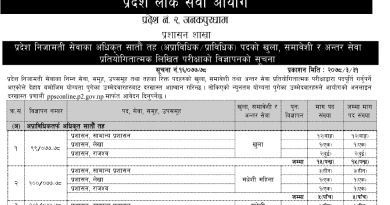Krishi Samagri Company ( KSCL ) Syllabus
KSCL Assistant (Level 4) Syllabus :- PDF HEre



KSCL Senior Assistant (Level 5) Syllabus PDF Here
KSCL Computer Operator (Level 5) Syllabus
KSCL Section Officer (Level 6)
1. Computer Fundamentals
1.1. Computer: – Definition, History, Generation, Characteristics, Types & Applications.
1.2. Overview of a computer system:-
1.2.1. Data and data processing
1.2.2. Hardware
1.2.2.1. Definition of Hardware
1.2.2.2. Input Unit: – Keyboard, Mouse, Scanner, etc
1.2.2.3. CPU:- Arithmetic Logic Unit (ALU), Control Unit (CU), Memory Unit (MU)
1.2.2.4. Output Unit:- Monitor, Printer, etc
1.2.2.5. Storage devices:- Primary & Auxiliary Memory (Floppy Disk, Hard Disk, Compact Disk, DVD, Flash disk etc.)
1.2.2.6. Others:- Network card, Modem, Sound card, etc.
1.2.3. Software
1.2.3.1. Definition & Types of Software
1.2.3.2. Programming Language
1.2.4. Liveware
1.2.5. Firmware and Cache Memory
1.3. Setting & protection of Computer Room and Computer
1.4. Concept of Computer related threats (virus, worms, Trojan, phishing etc) remedies and protection
1.5. Concept of Multimedia
1.6. File Management basic:
1.6.1. Physical Structure of the disk
1.6.2. Concept of File and folder
1.6.3. Wildcards and Pathname
1.6.4. Type of files and file extensions
1.7. Computer Networking
1.7.1. Introduction to Networking
1.7.2. Types of Network (LAN, MAN, WAN etc)
1.7.3. Concept of E-mail / Internet / Extranet / Intranet, World Wide Web (WWW)
1.7.4. Familiarity with internet browsers (e. g Internet explorer, Firefox, Opera, Safari, Google Chrome etc)
1.7.5. Introduction to IP address, subnet mask and default gateway
1.7.6. Introduction to Network Media, Topology and Protocol
1.7.7. Setting Up Microsoft Network
1.7.8. Dial-Up Networking 1.8. Number Systems
1.8.1. Introduction to binary, octal, decimal and hexadecimal number systems
1.9. Introduction to ASCII and Unicode standards
1.10. IT policy of Nepal
1.11. Electronic Transaction Act 2008
2. Operating System
2.1. Introduction to Operating System
2.2. Types of Operating System
2.3. Functions of Operating Systems
2.4. Command line operation (e. g. copy command, move command, command to view and set different file attributes etc)
2.5. Windows
2.5.1. Introduction to GUI
2.5.2. Introduction of Windows Operating System
2.5.2.1. Basic Windows Elements – Desktop, Taskbar, My Computer, Recycle Bin, etc.
2.5.2.2. Starting and shutting down Windows
2.5.2.3. File Management with Windows Explorer
2.5.2.4. Windows applications: (e.g. Control Panel, Character Map, Paint etc) 2.5.2.5. Finding files of folders and saving the result
2.5.2.6. Starting a program by command line operation
2.5.2.7. Changing window settings
2.5.2.7.1. Adding/Removing programs
2.5.2.7.2. Clearing the contents of document menu
2.5.2.7.3. Customizing the taskbar
2.5.2.7.4. Control panel items
2.5.2.8. Creating shortcut (icons) on desktop
2.5.2.9. System tools:- disk scanning, disk defragmenter, backup, restore, format
3. Word Processing
3.1. Concept of Word Processing
3.2. Types of Word Processing
3.3. Introduction to Word Processor
3.3.1. Creating, Saving and Opening the documents
3.3.2. Elements of Word Processing Environment (Menu, Toolbars, Status bar, Rulers,
Scrollbars, etc.)
3.3.3. Copying, Moving, Deleting and Formatting Text (Font, Size, Color,Alignment, line & paragraph
spacing)
3.3.4. Finding and Replacing Text
3.3.5. Familiar with Devnagari Fonts
3.3.6. Creating lists with Bullets and Numbering
3.3.7. Creating and Manipulating Tables
3.3.8. Borders and Shading
3.3.9. Use of Indentation and Tab Setting
3.3.10. Creating Newspaper Style Documents Using Column
3.3.11. Inserting Header, Footer, Footnotes, Endnotes, Page Numbers, File, Page break,
Section break, Graphics, Pictures, Charts, Word Art, Symbols & Organization Chart
3.3.12. Opening & Saving different types of document
3.3.13. Changing Default settings
3.3.14. Mail Merge
3.3.15. AutoCorrect, Spelling and Grammar Checking, and Thesaurus
3.3.16. Customizing menu & toolbars
3.3.17. Security Technique of Documents
3.3.18. Master Document, Cross Reference, Index, Table of Content.
3.3.19. Setting Page Layout, Previewing and Printing Documents
4. Electronic Spreadsheet
4.1. Concept of Electronic Spreadsheet
4.2. Types of Electronic Spreadsheet
4.3. Organization of Electronic Spreadsheet application (Cells, Rows, Columns, Worksheet,
Workbook and Workspace)
4.4. Introduction to spreadsheet application
4.4. 1. Creating, Opening and Saving Work Book
4.4.2. Elements of Electronic Spreadsheet Environment (Menu, Toolbars, Status bar,
Rulers, Scrollbars, etc.)
4.4.3. Editing, Copying, Moving, Deleting Cell Contents
4.4.4. Familiar with Devnagari Fonts
4.4.5. Formatting Cells (Font, Border, Pattern, Alignment, Number and Protection)
4.4.6. Formatting Rows, Column and Sheets
4.4.7. Using Formula – Relative Cell and Absolute Cell Reference
4.4.8. Using basic Functions
4.4.9. Generating Series
4.4.10. Changing default options
4.4.11. Sorting and Filtering Data
4.4.12. Summarizing Data with Sub Totals
4.4.13. Creating Chart 4.4.14. Inserting Header and Footer
4.4.15. Spell Checking
4.4.16. Customizing Menu & Toolbars
4.4.17. Importing from and Exporting into other Formats
4.4.18. Pivot Table, Goal Seek, Scenario & Audit
4.4.19. Page Setting, Previewing and Printing
5. Database System
5.1. Introduction to Data, Database and DBMS
5.2. Basic Concept of Tables, Fields, Records, Relationships and Indexing
5.3. Introduction to database application
5.3.1. Data Types
5.3.2. Creating, Modifying & Deleting Tables and Formatting & Validating Field Data
5.3.3. Creating, Modifying, Deleting & Using Simple Queries
5.3.4. Creating, Modifying & Deleting Forms/Reports/Macros
6. Presentation System
6.1. Introduction to presentation application
6.1.1. Creating, Opening & Saving Slides
6.1.2. Formatting Slides 6.1.3. Slide Show
6.1.4. Animation 6.1.5. Inserting Built-in picture, Picture, Table, Chart, Graphs, Organization Chart etc.
7. Web page Designing
7.1. Introduction to Web Page and CMS (Content Management System) 7.2. Introduction to HTML
7.2.1. HTML document
7.2.2. Tags
7.2.3. Skeleton & Flesh
7.2.3.1. Text
7.2.3.2. Hyperlinks
7.2.3.3. Images
7.2.3.4. Lists & forms
7.2.3.5. Tables
7.2.3.6. Frames
Copmputer Operator PDF


